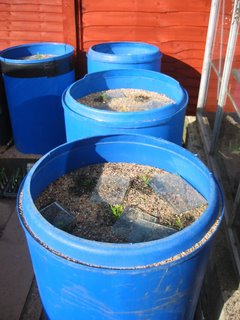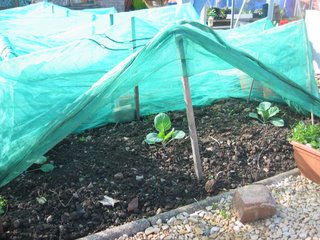

If you’ve ever been to a flower and vegetable show and wondered how the growers get their carrots and parsnips 4’ long then here is how it is done.
The secret is to get hold of some old oil drums or barrels, cut out the tops and bottoms and fill them with sand. 5 or 6 conical holes 3”across at the top are bored into the sand with a stout metal rod. The growers ‘special’ mix is sprinkled into the holes. In actuality this is nothing more than sieved compost/garden soil/vermiculite with a few ounces of fertilizers such as superphosphates and calcified seaweed. (I'll talk about this more during March and April when I do mine)
Around the middle of April a few carrot seeds are sown into a small indentation at the top of the compost ‘cone’ and covered. After 3 or 4 weeks when the seedlings are growing away, select your strongest seedling and cut the rest out at soil level.
A pane of glass over the top of each drum is necessary to stop cats digging in the sand (bless em!) and watering should be done sparingly in the early days to just keep the top surface moist. Once the carrots are well established the moisture in the sand should be sufficient and many growers cover them over from July so that no water gets to them whatsoever, thus encouraging the roots to go down in search of moisture.
There is no feeding required during the season as there should be sufficient fertilizers in the ‘mix’. However, a foliar feed can be given at intervals such as phostrogen.
Extracting the roots on show day is the moment of truth. If everything was prepared properly all those months ago you should have long, tapering roots that look superb on the show bench. It can take 20 minutes to get each one from its ‘station’ intact…you want to get as much of the fine tap root up as possible so a lot of care must be taken. A soft sponge and clean water should be used to clean them carefully and all the fine root hairs should be removed. Reduce the foliage to 75mm if the schedule asks for it and display side-by-side on the show bench. Then all you have to do is await the ‘red card’.
The carrots shown above are from the National Vegetable Society Midland Championships held at Malvern at the end of September, grown by Jack Arrowsmith who manages to grow huge roots about 6' long. You don't have to get them this long or big but with a little effort you can achieve 3 to 4' quite easily.
Why not have a go? You’ve got the rest of the winter to get everything ready!








